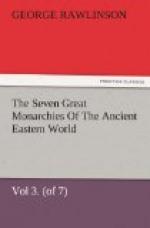Besides this upper robe, which is the only garment shown in the sculptures, the Medes wore as under garments a sleeved shirt or tunic of a purple color, and embroidered drawers or trousers. They covered the head, not only out of doors, but in their houses, wearing either felt caps like the Persians, or a head-dress of a more elaborate character, which bore the name of tiara or cidaris. This appears to have been, not a turban, but rather a kind of high-crowned hat, either stiff or flexible, made probably of felt or cloth, and dyed of different hues, according to the fancy of the owner. [PLATE VI., Fig. 1.]
The Medes took a particular delight in the ornamentation of their persons. According to Xenophon, they were acquainted with most of the expedients by the help of which vanity attempts to conceal the ravages of time and to create an artificial beauty. They employed cosmetics, which they rubbed into the skin, for the sake of improving the complexion. They made use of an abundance of false hair. Like many other Oriental nations, both ancient and modern, they applied dyes to enhance the brilliancy of the eyes, and give them a greater apparent size and softness. They were also fond of wearing golden ornaments. Chains or collars of gold usually adorned their nocks, bracelets of the same precious metal encircled their wrists, and earrings were inserted into their ears. [PLATE VI., Fig. 2.] Gold was also used in the caparisons of their horses, the bit and other parts of the harness being often of this valuable material.
We are told that the Medes were very luxurious at their banquets. Besides plain meat and game of different kinds, with the ordinary accompaniments of wine and bread, they were accustomed to place before their guests a vast number of side-dishes, together with a great variety of sauces. They ate with the hand, as is still the fashion in the East, and were sufficiently refined to make use of napkins. Each guest had his own dishes, and it was a mark of special honor to augment their number. Wine was drunk both at the meal and afterwards, often in an undue quantity; and the close of the feast was apt to be a scene of general turmoil and confusion. At the Court it was customary for the king to receive his wine at the hands of a cupbearer, who first tasted the draught, that the king might be sure that it was not poisoned, and then presented it to his master with much pomp and ceremony.
The whole ceremonial of the court seems to have been imposing. Under ordinary circumstances the monarch kept himself secluded, and no one could obtain admission to him unless he formally requested an audience, and was introduced into the royal presence by the proper officer. On his admission he prostrated himself upon the ground with the same signs of adoration which were made on entering a temple. The king, surrounded by his attendants, eunuchs, and others, maintained a haughty reserve, and the stranger only beheld him from a distance. Business was transacted in a great measure by writing. The monarch rarely quitted his palace, contenting himself with such reports of the state of his empire as were transmitted to him from time to time by his officers.




